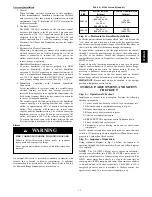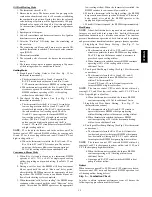
4
Table 1 – Minimum Clearances to Combustible Materials -- In. (mm)
UNIT APPLICATION
UPFLOW
DOWNFLOW
HORIZONTAL
Sides
Furnace
0 (0)
2 (51)
2 (51)
Supply Plenum and Warm---Air Duct Within 6 ft. (1.8 M) of
Furnace
1 (25)
2 (51)
1 (25)
Back
Service Clearance
0 (0)
1 (25)
4 (102)
Top
Furnace Casing or Plenum
2 (51)
2 (51)
2 (51)
Horizontal Warm---Air Duct Within 6 ft. (1.8 M) of Furnace
2 (51)
2 (51)
3 (76)
Flue
Pipe
Horizontally or Below Pipe
4 (102)
4 (102)
4 (102)
Vertically Above Pipe
9 (229)
9 (229)
9 (229)
Front
8 (203)
8 (203)
8 (203)
Bottom*
0 (0)
0 (0)
0 (0)
* For combustible floor, use approved subbase.
Note: Adequate service clearances should be provided over and above these dimensions as required.
The furnace should be located as close as possible to chimney or
vent in order to keep vent connections short and direct. The
furnace should also be located as near as possible to center of air
distribution system.
Step 2 — Location Relative to Cooling Equipment
When installing furnace with cooling equipment for year--round
operation, the following recommendations must be followed for
series or parallel airflow:
1. In series--airflow applications, coil is mounted after furnace
in an enclosure in supply--air stream. The furnace blower is
used for both heating and cooling airflow.
2. In parallel--airflow applications, dampers must be provided
to direct air over furnace heat exchanger when heat is
desired and over cooling coil when cooling is desired.
UNIT DAMAGE HAZARD
Failure to follow this caution may reduce the life of this unit.
The coil MUST be installed on air--discharge side of furnace.
Under no circumstances should airflow be such that cooled,
conditioned air can pass over furnace heat exchanger. This
will cause condensation in heat exchanger and possible
failure of heat exchanger. Heat exchanger failure due to
improper installation may not be covered by warranty.
CAUTION
!
IMPORTANT
: The dampers should be adequate to prevent cooled
air from entering furnace. If manually operated, dampers must be
equipped with a means to prevent operation of either cooling unit
or furnace unless damper is in full cool or heat position.
INSTALLATION
Step 1 — Air for Combustion and Ventilation
CARBON MONOXIDE, UNIT RELIABILITY HAZARD
Failure to follow this warning could result in personal injury,
death and/or property damage.
Installation of this furnace in an area where it will receive
contaminated combustion air must be avoided. Such
contamination would include the following: ammonia,
chlorine, hydrogen sulfide, halogenated hydrocarbons, carbon
tetrachloride, cleaning solvents, hydrochloric acid, water
softening chemicals, and similar chemicals.
!
WARNING
CARBON MONOXIDE, FIRE HAZARD
Failure to follow this warning could result in personal injury,
death and/or property damage.
Do not block combustion--air openings in the furnace. Any
blockage could result in improper combustion.
!
WARNING
Step 2 — General
This furnace should be installed in a location in which facilities for
ventilation permit satisfactory combustion of oil, proper venting,
and maintenance of ambient temperature at safe limits under
normal conditions of use. The location should not interfere with
proper circulation of air within the confined space. (See NFPA--31
or B139.)
In addition to air needed for combustion, process air shall be
provided as required for: cooling of equipment or material,
controlling dew point, heating, drying, oxidation or dilution, safety
exhaust, and odor control.
In addition to air needed for combustion, air shall be supplied for
ventilation, including all air required for comfort and proper
working conditions for personnel.
The barometric draft regulator (included with furnace) shall be
installed in same room or enclosure as furnace in such a manner as
to prevent any difference in pressure between regulator and
combustion--air supply.
Air requirements for operation of exhaust fans, kitchen ventilation
systems, clothes dryers, and fireplaces shall be considered in
determining the adequacy of a space to provide combustion--air
requirements.
The lack of a proper amount of combustion air can lead to serious
furnace operational problems. Some of these problems are:
1. Excessive oil burner after--drip and oil fumes.
2. Sooting.
3. Melted oil burner igniter/relay control.
4. Air band or air turbulator settings more open than normal.
5. Lockouts on start--up.
The requirements for combustion and ventilation air depend
upon whether furnace is located in a CONFINED or
UNCONFINED space.
Unconfined Space
An unconfined space must have at least 50 cu ft for each 1,000
BTUH of total input for all the appliances (such as furnaces,
clothes dryers, water heaters, etc.) in the space.
In unconfined spaces in buildings of conventional frame, brick, or
stone construction, infiltration MAY be adequate to provide air for
combustion, ventilation, and dilution of flue gases. This
determination must be made on an individual installation basis and
must take into consideration the overall volume of unconfined
374RAN





































